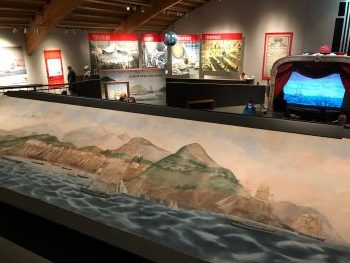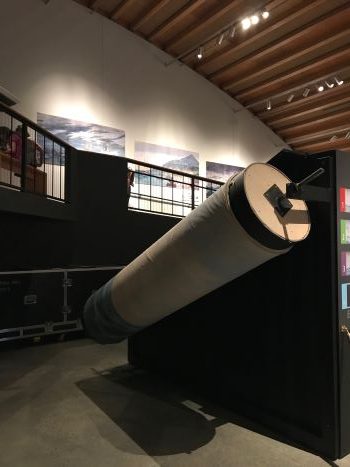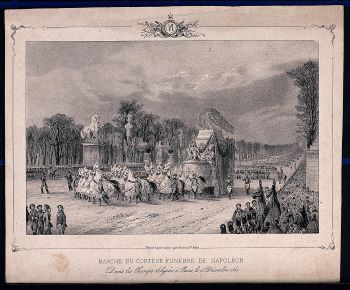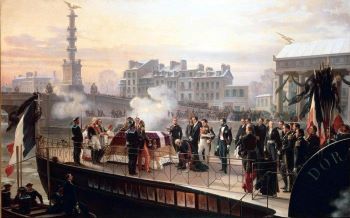Instructive Entertainments: Early 19th Century Panoramas
Often there is no substitute for seeing an actual museum artifact from the past instead of its digital surrogate, especially if that artifact is a large-scale one. Even the finest quality images on a regular computer screen can’t adequately convey the feeling one has when in the presence of something that is really big. That said, seeing the real thing along with interpretive digital media combines the best of both worlds since digital images offer their own advantages, such as revealing greater detail than we ordinarily see, for example. I recently visited such an exhibit and wanted to share a bit of that experience in this blog post since it relates to a topic that has come up in several of P. T. Barnum’s copybook letters.
Barnum often mentioned panoramas in his letters, which is not too surprising since stationary and moving panoramas were a very popular form of entertainment in his day. The static versions were typically mounted inside round structures, rotundas, that later came to be called cycloramas. The moving versions could be shown in theatres, or similar such spaces, and Barnum was interested in purchasing or renting moving panoramas to show in the “Lecture Hall” (theatre) of his American Museum. So when I learned that an actual 1840s panorama was on exhibit at Mystic Seaport Museum in Connecticut, I jumped at the opportunity to go and see it. I wanted to get a feel for an experience that people in the past enjoyed, and add depth to my understanding of what Barnum was writing about. Panoramas were, after all, among the forms of “instructive entertainment” that he desired to offer the public coming to his museum, which is to say, he sought attractions that were simultaneously “awesome” and at least superficially educational, appealing to the masses.

The panorama I saw is a rarity to be sure, since the usable life of an 18th- or 19th-century moving panorama was shortened by constant travel from place to place, each time being installed and de-installed, spooled through multiple times, then packed up and transported again—and not by art handlers! Under those conditions they became tattered and worn, and as Barnum himself noted in a letter of September 11, 1845: “I have seen the old Panorama of Napoleon’s funeral—it was exhibiting at the races, but it is worn out.” Eventually, as new forms of visual entertainment came along, panoramas in storage were relegated to rubbish heaps or stowed in forgotten places that practically ensured their ruin. So there aren’t many around, at least not the early ones.
The story of this 1848 panorama depicting a three-year whaling voyage is not only a fascinating one in terms of how it was made, but also a tale of great luck. All but one section, which went missing 100 years ago, has survived. It is now owned by the New Bedford Whaling Museum in Massachusetts, and thanks to the talents of professional conservators and digitization wizards, the panorama has been brought to life once again. If you have an opportunity to get to Mystic, Connecticut, before March 27, 2022, I highly recommend a visit to see the full exhibition, A Spectacle in Motion: The Grand Panorama of a Whaling Voyage ‘Round the World.
Because this eight-foot high panorama was created as a moving spectacle, its length is quite impressive: 1275 feet (388.62 meters) long. It is divided into four sections, each one wrapped on its own giant spool. Because of the now delicate condition (though stabilized after conservation), it can’t be displayed as it was originally, in motion, nor can it be shown upright. Instead the museum created a display structure in which the huge spools flank a 30-foot span that supports the painted cloth at an angle. Every three weeks expert museum staff roll the panorama to the next 30-foot segment, and change to the next spool when one reaches the end. You can see some of that process in this video and if you are interested in seeing a particular segment on site, check the museum’s website for the schedule of scenes. A mini-theatre in the gallery allows visitors to see the entire (digitized) panorama in motion, with a narrator explaining the various scenes, just as would have been done originally. In terms of subject matter, a voyage with a storyline complemented by exotic or unusual scenery, like an erupting volcano and uniquely formed islands, is well suited to the format of a moving panorama.

There are also interactive exhibits that allow visitors to explore various facets of its historical context and the stories of the artists, as well as learn about the meticulous (and daunting) conservation process. Artifact displays include items from several of the distant locations on the voyage, and the diary of Charles Wain Morgan who described seeing this panorama when it was first shown in 1848. Hard to believe, but the two men who collaborated to paint this epic panorama, Benjamin Russell and Caleb Purrington, completed it in just 14 months! Russell was actually a participant in the whaling voyage depicted, which lasted from 1841 to 1844, and during that time he must have made numerous drawings and taken careful notes—the detail of the landscapes, seascapes, human and sea life activities, specific buildings, and accuracy of the vessels portrayed in the panorama is astonishing. Seeing it helped me understand the nature of the product that Barnum was commissioning from a Mr. Lambert while he was in Europe, though the manner in which it was painted may have been quite different.
Barnum began his quest to acquire a panorama in mid-August of 1845 when he was in Paris. He wrote to his agent in Paris, Mon. Huet, that he had “recd a letter from Messrs Molteni & Co the opticians, and that unfortunately their demands are too great for me.” By way of explanation, he added,
They ask 10,000 Francs for the Panoramas—viz 8000 for that of Napoleon and 2000 for Versailles. This is quite too much. There is already a Panorama existing representing the funeral of Napoleon. It was made somewhere in Paris, and perhaps it is now there and may be bought for a low price. I wish you to try to learn where it is and whether it is for sale.
Ten days later, on August 28th, he reported to Fordyce Hitchcock, manager of the American Museum, that he had “found this regarding the Panorama & [I] send it to you.” Exactly what “this” was he didn’t say, but he went on to describe what he did with it.
I cut the figures so as to turn them under while showing the letter to another Frenchman who talked of making me a similar Panorama. My plan now is to try to buy a good one ready made, if I can do so.
That Barnum was aiming for a moving panorama, not a static one, is clear in his request to Hitchcock: “I wish you once more to send me what is the size of our stage—the height, width & depth. It is necessary sometimes for me to know that.”
On September 11th, in the same letter that commented about the worn out panorama of Napoleon’s funeral, Barnum seemed uncertain of his next move. He remarked to his unidentified correspondent (possibly Mon. Huet),
I must abandon the thought of having that panorama at least for the present—the price asked is quite too high and it would be nonsense to have Lambert make it for a less price than he already named, for he would produce an inferior article for a less sum, and that would not do for me. So I must give it up.
This may have been a ploy to get a better price, as he continued in this letter, “I will not submit to being swindled; 4000 Francs ought to produce a magnificent and perfect panorama of the subject which I want—and some day I will find the artist in Paris who will do it.” Despite the tone of dissatisfaction, the very same day Barnum wrote to Fordyce Hitchcock, manager of the American Museum, to inform him,
I have engaged the Panorama of Napoleons funeral. The same artist is doing it whom Molteni was to employ & for which he was to charge me 8000 francs. I have engaged it for 6000 francs thus saving 400 dollars. I shall also introduce the funeral of Lafayette—costing perhaps 800 or 1000 francs more. They are to be done in July.

(Wikimedia Commons; courtesy of the Wellcome Collection, Wellcome Trust, UK)
The last statement sets a timeframe of over nine months, and I would assume that a depiction of Napoleon’s re-interment funeral, grand as it was, would not require as much textile real estate as a three-year whaling voyage. When Barnum wrote to Boston showman Moses Kimball in mid-November, boasting of his commissions of an anatomical Venus and a panorama, he referred to the latter as “a Moving Panorama & Diorama representing the Funeral of Napoleon.” Perhaps the diorama was to be displayed in the museum as an enticement to visitors to see the panorama in the Lecture Hall. As with the Dissolving Views also to be shown in the Lecture Hall, a narrator would need to be hired to explain the scenes to the audience as the scenery advanced. Such a person, I imagine, would need to be skilled at engaging audiences since the subject of Napoleon’s funeral was probably not quite as compelling to Americans as it was to the French. Even so, just seeing a moving panorama was novel and entertaining, and an “experience” to share with friends.
Perhaps because Barnum’s commissioned panorama would not be finished for months to come—plus the additional time for packing and shipping—he contacted Hitchcock in late January of 1846 to float the idea of renting a number of panoramas from a man in Scotland. These he could have sent to New York right away, along with a narrator. Writing to his museum manager from Arbroath, Scotland, Barnum described the opportunity as follows:
A Mr Marshall of Scotland has some 20 or 30 Panoramas of all sorts (moving)—they are good—I send a [hand]bill of 2 or 3—He would send a man to America with 6 or 8 if we want for a year. I don’t know yet for what price—but suppose about $20 per week—perhaps much more. He is to give me his price in 10 days. I’ll not engage them till I hear from you.
This “Mr. Marshall” was undoubtedly one of the men in the father-son partnership of Peter and William Marshall. In the 1810s they developed “peristrephic” or moving panoramas that used very large rollers, cranked by hand. “Marshall,” Barnum noted, “has got rich in the business.” Adding details on the panorama subjects and the mechanics of showing them, he continued,
He [Marshall] has a lot of Panoramas: “Battle of Waterloo,” Napoleon at Elba, St. Helena & c—also the scene of the “Tournament” held in Scotland some years since—the “Frozen Regions” & many others [that are] lying still, and he said if we could agree upon price he would send a man over with them. They are well painted & are I think quite effective. They will fit on stage & can be shown & wound up on a cylinder & put out of the way in no time. About 3 might be shown in 3/4 of an hour.
With a second museum now on his plate, Barnum also thought the rented panoramas could be sent to Baltimore for his uncle Alanson Taylor to use. “I wish you to think of it,” he told Hitchcock, “& also send the [hand]bill to Taylor & let him think of it & then you write me your opinions.” He mentioned that he had not told Marshall he had two museums, “but if I hire them I shall use them when & where I please so that by getting another man or two in America to explain them, we could have them distributed & showing in N.Y., Baltimore & perhaps in Boston or Philadelphia at the same time.”
Barnum even went so far as to suggest they might copy these panoramas, though whether this would be achieved by getting quick sketches or by depending upon the visual memory of an artist is not clear. The state of photography at this time would not have allowed for taking pictures on the sly. In any case, Barnum was racing way ahead with this copying idea since he did not yet know if he and Marshall would agree on terms. His determination not to be defeated or outdone seems to have been a driving factor in figuring out how to get panoramas and get them as cheaply as possible. He confided to Hitchcock,
If we had good pictures to copy from, perhaps an artist might be found in America to get them up for us—or I could pick up such an artist here & send him over—but whether that would not be more expensive than to hire these is a question. In fact I have no idea what Marshall would ask for them, I only know that he has several stored in his place in Edinburgh & it seems to me that he would sooner have them earn a few pounds per week than to be still—but perhaps not. He has agreed to give me his terms in a few days.
Curiously, Marshall’s price does not appear in any of Barnum’s subsequent letters to Hitchcock, but he did return to the subject of renting Marshall’s panoramas six weeks later in a March 18th letter, and again on March 31st. The single sentences do not tell us as much, other than that the arrangement was still being considered. Barnum stated without further explanation, “Thank you for your hints about Marshall’s Panorama” and two weeks later noted, “I have written Mearshall [Marshall] about the Panoramas and shall get his answer in time to write you by the Great Western [Steamship].” That’s probably all we will learn from the copybook letters about this particular endeavor, but there is a bit more to mine from Barnum’s letters concerning the panorama he had commissioned in Paris.

He wrote to agent Huet on February 12th and despite the passage of several months since making the agreement with Lambert, the painting of the panorama does not seem to have been started, though the scenes may have been sketched. The language suggests that Mr. Lambert’s artistic responsibility was limited to sketching the canvas but not painting it. Barnum replied to Huet,
I am glad Mr Lambert is getting along so well with the Panorama. I hope he will not fail to have a first rate artist paint the sce[nes] one who understands light and shade, distance & c. If he finishes it by May or June it will be quite on time.
A week later Barnum replied to a letter from Messrs. Draper & Co to clarify the financial arrangements he had made with Lambert. Apparently Lambert had gone to Messrs. Draper looking for an advance on his contract with Barnum. While Barnum was flattered and felt “much obliged” for their “kind and voluntary offer to advance the sum” on his behalf, he stated in no uncertain terms that his agreement with Lambert did not include advances.
Mr Lambert knows full well that I totally declined entering into any engagement with him which required me to advance a single sou; and I still decline it, but the moment his work is finished according to our treaty that moment the money shall be handed him and the sooner it is finished the better I shall like it.
Barnum explained that in principle he was “quite averse to paying in advance—[as] it gives the person who received the money an undue and unjust advantage over the person paying it.” He was aware, nonetheless, that Lambert would have upfront costs such as the canvas or cotton cloth and its preparation, and Barnum expected that materials could be gotten on credit. He thus added,
Mr Lambert holds a writing with my signature binding me to pay him the 6000 francs as soon as the work is completed according to contract, and by exhibiting that writing to those from whom he is making purchases, they will give him credit provided they have confidence in him, and provided also they are assured of my responsibility, which I trust they will be [up]on consulting you.
So what was Barnum paying for his “grand panorama?” He had stated in a letter to Hitchcock that he shaved 2000 francs or $400 off the 8000 francs Molteni was going to charge. Since that would be four hundred “1846 dollars” we have to calculate what that would mean in today’s dollars. Such estimates can only be very approximate when the span of time is so long, but using a Consumer Price Index inflation calculator shows that the $1200 (6000 francs) Barnum promised to pay Lambert would be equivalent to about $42,500 today. Renting panoramas from Marshall at $20 per week—Barnum’s guess at what he might charge—would be equivalent to about $709 in today’s dollars. The acquisition of a panorama was a substantial investment in its day and it was a risky one; many, perhaps most, failed to generate the kind of financial rewards their owners hoped for. Barnum’s resolve not to overpay was a wise one.
I do encourage you to see the Grand Panorama exhibition at Mystic Seaport since it is a rare opportunity to see a once-popular type of entertainment, but if getting to southern New England is out of the question, take a look at their video. Just keep in mind that the panorama is a lot bigger and more impressive in real life than the camera suggests—the height of the cloth from sea to sky is actually the same as a typical room!
Adrienne Saint-Pierre
Barnum Museum Curator

